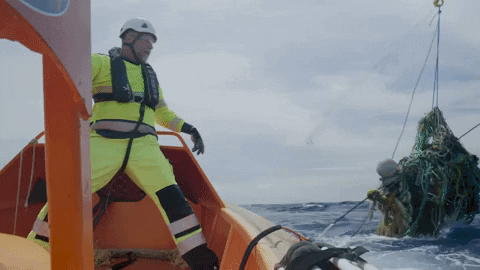
First North Sea Prototype
Making modifications on a small scale structure 10 miles offshore is relatively easy. In contrast, making corrections on a large scale structure 1000 miles offshore would be an entirely different challenge – at a different cost. Therefore, The Ocean Cleanup deployed a 100 meter-long barrier segment in the North Sea, 23 km off the coast of The Netherlands on the 22nd of June 2016. It was the first time our design was put to the test in open waters and the tests conducted gave valuable insights to our engineering team.
Our passive cleanup system uses the natural ocean currents to collect and concentrate the plastic. By placing long, floating cleanup system in the Great Pacific Garbage Patch between Hawaii and California, we can clean up the accumulated plastic and prevent it from breaking down into even more harmful microplastic over time. Our design needs to withstand harsh weather conditions and constant wear and tear. Since our technology is the first of its kind, we believe the best way to move forward is to test often and fast and make iterative improvements based on these tests.
OBJECTIVE AND SET-UP
To investigate the durability of our design, we deployed a system segment in the North Sea. At this test site, conditions are more severe than those in the Pacific Ocean, due to the North Sea’s strong tidal currents, and the test site’s short, steep wave patterns.
The objective of the North Sea prototype was twofold;
- Test the boom design on a small-scale for survivability in extreme conditions
- Gaining experience as an organization in the ocean deployment of a cleanup array

FINDINGS
During an inspection of the North Sea prototype in August, we noticed the two outermost air chambers were bent out of shape. Thanks to underwater footage we were quickly able to pinpoint the cause; shackles had disconnected from the mooring, which increased the forces on the ones remaining as well as the floater. After our diagnosis, we continued to closely observe the situation and decided to take the barrier back to shore after close to two months.
ITERATING TOWARDS EXECUTION
The data gathered is used to help engineers develop a system fully resistant to severe conditions of the ocean once deployed in the North Pacific. Thanks to the North Sea prototype test, we also learned how the chosen material proved to be suboptimal for the purpose. The results of this test were strong support in making the conclusion not to move ahead with inflatable floaters that were derived from standard oil-collection booms, but rather turn to rigid HDPE pipes instead.

Royal Haskoning BV made an environmental quick scan for the North Sea Prototype:
MORE RECENT PROTOTYPES
Our design has changed substantially since the first North Sea prototype, with the most noticeable one being the change from a moored system to a free-floating system. The location allotted to us by the Dutch government still offers a great set-up for endurance testing our new system components. Since the first North Sea prototype, we have deployed a second (2017) and a third (2018) prototype, to test new elements from of our design.
